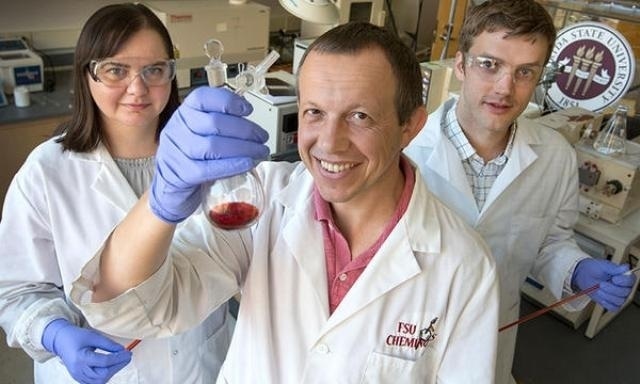Mar 10 2016
Florida State University researchers have discovered a way to safely activate red phosphorus, an element that will be critical in the creation of new electronics and the materials of the future.
 Alina Dragulescu-Andrasi, FSU postdoctoral researcher; Michael Shatruk, professor of chemistry and biochemistry at FSU; and Zane Miller, who recently earned his doctorate from the FSU Department of Chemistry. (FSU Photography Services)
Alina Dragulescu-Andrasi, FSU postdoctoral researcher; Michael Shatruk, professor of chemistry and biochemistry at FSU; and Zane Miller, who recently earned his doctorate from the FSU Department of Chemistry. (FSU Photography Services)
The discovery, which details the process to activate red phosphorus using inexpensive and widely available potassium ethoxide dissolved in ethanol, was achieved by FSU Professor of Chemistry and Biochemistry Michael Shatruk, FSU postdoctoral researcher Alina Dragulescu-Andrasi, former FSU Professor of Chemistry Tyler McQuade, and Zane Miller, who recently earned his doctorate from the FSU Department of Chemistry. The research team’s findings were published today in the top chemistry journal Angewante Chemie.
This research is significant because current exploration of the uses and benefits of phosphorus are hampered by the volatile and highly flammable nature of the white form of the element, which has been generally used as the entry to the chemistry of phosphorus compounds in solutions.
“Activation of phosphorus is an important process for the preparation of semiconductors and low-dimensional electronic materials,” Shatruk said. “But industries currently have to choose between using white phosphorus, which is very hazardous, or red phosphorus, which until now has been considered difficult to activate at low temperatures or in large quantities. Our new methodology removes the barriers to using red phosphorus as the starting material and opens up a world of opportunity.”
The research team was able to activate red phosphorus using inexpensive potassium ethoxide in ethanol. The reaction can be performed with mild heating and provides access to soluble polyphosphide compounds. Those compounds can be used to explore the chemistry of phosphorus without the need to use flammable white phosphorus.
Phosphorus is most commonly used in fertilizers, incendiary devices and the production of steel, but its unique electrical properties make it a superior rival to graphene, the current go-to element for next generation electronics. Graphene, a single layer of graphite, is able to conduct electricity in remarkable ways, but has properties that make it difficult to regulate the flow of electricity and turn it on and off at will. Phosphorene, a single layer of phosphorus that was discovered only three years ago, is also an excellent conductor of electricity, but it allows the flow of electricity to be controlled, making it ideal for use in future electronics.
The research team’s work was funded by a Small Business Innovation Research (SBIR) grant in collaboration with Chemring Ordnance, a local company based in Perry, Fla. SBIRs enable small businesses to explore their technological potential while providing them with the incentive to profit from their commercialization efforts.
“Our breakthrough would not have been possible without the partnership of Chemring,” Shatruk said. “This is a great example of a local public-private partnership working to solve problems and push technology forward. We are very excited about FSU’s commitment to support and promote this kind of interaction.”
Source: http://www.fsu.edu/